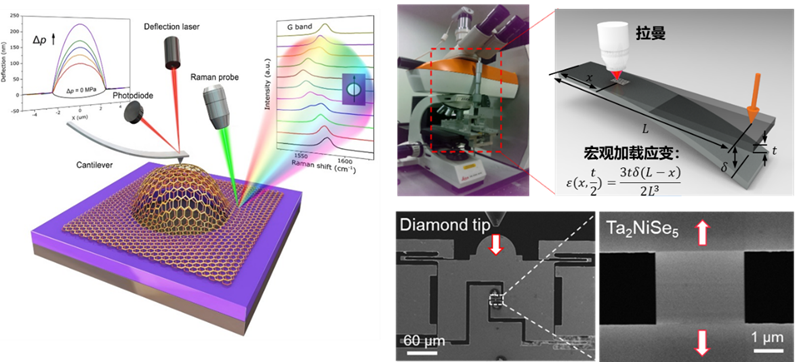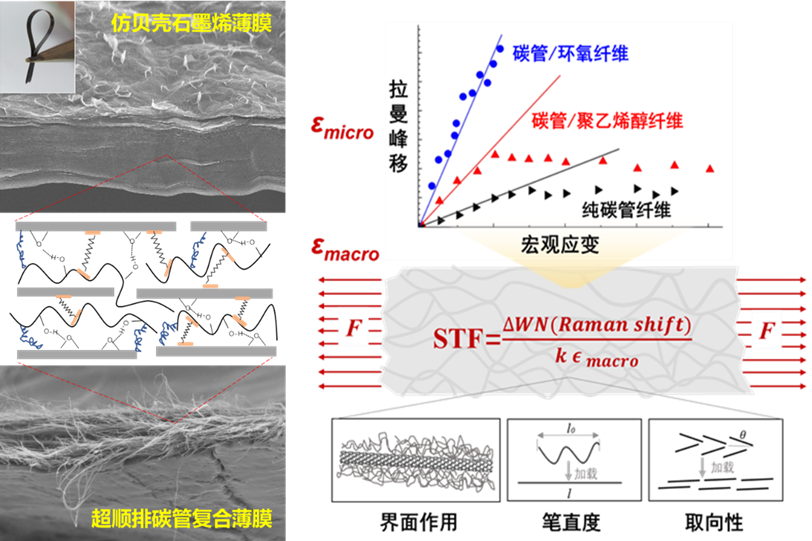Nano Mechanics
When the characteristic size of a material is controlled at the nanoscale, size effects, surface and interface effects, etc. will be introduced, giving rise to a series of novel physical and chemical properties. In addition, since the proportion of surface atoms of materials at the nanoscale is close to 100%, some originally weak non-covalent bonds such as van der Waals forces and hydrogen bonds become non-negligible, and even dominate the deformation and assembly behavior of nanomaterials and structures. From an application perspective, electronic devices are showing a trend of miniaturization. Nanomaterials, as an important component, are subjected to complex multimodal loads in practical applications, and their failure problems determine the robustness and reliability of the device. Therefore, how to analyze the mechanical properties of nanomaterials is one of the research focuses in the field of micro-nano mechanics. On the other hand, the design and manufacture of advanced materials often involve cross-scale mechanical problems. How to understand the mechanical properties of nanostructures and interfaces, and transfer them to the macroscopic scale through multi-level construction, and then establish the structure-performance relationship between nano-elements and macroscopic systems, is the most concerned scientific issue in the field of materials. In response to the above problems, we have carried out micro-nano mechanics research around the mechanical properties of nanomaterials and structures. The specific research directions include:
1. Develop dynamic/static micro-nanoscale mechanical characterization technologies and measurement methods, including quasi-static micro-nano bubbling technology, Raman spectroscopy mechanical testing technology, in-situ electron microscope MEMS micro-tensile testing technology, nanoindentation technology, friction microscopy, etc., as well as dynamic laser-induced nanoparticle impact testing and AFM nano-fatigue testing technology.

2. Accurately measure the mechanical properties of low-dimensional nanomaterials to obtain key mechanical parameters that describe material deformation and failure (such as Young's modulus, bending stiffness, fracture strength, fracture toughness, etc.). The research objects include two-dimensional materials represented by graphene and functional organic nanofilms and one-dimensional materials represented by carbon nanotubes and inorganic sub-nanowires.

3. Finely characterize the complex mechanical responses of nanostructured materials (including nanocomposites, macroscopic aggregates of nanomaterials, polycrystalline/multiphase materials, nanolattice materials, etc.) under different load modes, reveal the mechanism of the microstructure and interface on the overall mechanical behavior of the material, establish the cross-scale transmission law of material and structural properties, and guide the multi-level substructure design of advanced functional materials.

1.C. Wang, X. Cui, S. Wang, W. Dong, H. Hu, X. Cai, C. Jiang, Z. Zhang, L. Liu. Anisotropic mechanical properties of α-MoO3 nanosheets. Nanoscale 2024, 16, 4140-4147 PDF File
2.X. Cui, L. Liu, W. Dong, Y. Zhou, Z. Zhang. Mechanics of 2D material bubbles. Nano Res. 2023, 16, 13434-13449. PDF File
3.G. Wang, H. Hou, Y. Yan, R. Jagatramka, A. Shirsalimian, Y. Wang, B. Li, M. Daly, C. Cao. Recent advances in the mechanics of 2D materials. Int. J. Extreme Manuf. 2023, 5, 032002 PDF File
4.X. Cui, W. Dong, S. Feng, G. Wang, C. Wang, Z. Xu, L. Liu, Z. Zhang. Extra-High Mechanical and Phononic Anisotropy in Black Phosphorus Blisters. Small 2023, 19, 2301959 PDF File
5.G. Wang, F. Najafi, K. Ho, M. Hamidinejad, T. Cui, G. Walker, C.V. Singh, T. Filleter. Mechanical size effect of freestanding nanoconfined polymer films. Macromolecules 2022, 55, 1248–1259 PDF File
6.Y. Hou, S. Zhang, Q. Li, L. Liu, X. Wu, Z. Zhang. Evaluation local strain of twisted bilayer graphene via moiré pattern. Opt. Lasers Eng. 2022, 152, 106946. PDF File/a>
7.Y. Cui, G. Wang, W. Wang, X. Cui, W. Dong, C. Wang, M. Jin, T. He, Z. Zhang, L. Liu. Trade-off between interface stiffening and Young's modulus weakening in graphene/PMMA nanocomposites. Compos. Sci. Technol. 225, 109483. PDF File
8.W. Wang, X. Ma, Z. Dai, S. Zhang, Y. Hou, G. Wang, Q. Li, Z. Zhang, Y. Wei, L. Liu. Mechanical Behavior of Blisters Spontaneously Formed by Multilayer 2D Materials. Adv. Mater. Interfaces 2022, 9, 2101939. PDF File
9.T. Qureshi#, G. Wang#, S. Mukherjee, M. A. Islam, T. Filleter, C. V. Singh, D. K. Panesar. Graphene-based anti-corrosive coating on steel for infrastructural applications: Challenges and Potential. Constr. Build. Mater., 2022, 351, 128947. PDF File
10.Y. Hou, Z. Dai, S. Zhang, S. Feng, G. Wang, Z. Xu, L. Liu, Q. Li, Z. Zhang. Elastocapillary cleaning of twisted bilayer graphene interfaces. Nat. Commun. 2021, 12, 1-9. PDF File
11.G. Wang, Z. Zhang, Y. Wang, E. Gao, X. Jia, Z. Dai, C. Weng, L. Liu, Y. Zhang and Z. Zhang. Out-of-Plane Deformations Determined Mechanics of Vanadium Disulfide (VS2) Sheets. ACS Appl. Mater. Interfaces, 2021, 13, 3040-3050. PDF File
12.G. Wang, L. Liu, Zhang, Z. Interface Mechanics in Carbon Nanomaterials-based Nanocomposites. Compos. Part A, 2021, 141, 106212. PDF File
13.T. Arif#, G. Wang#, G. Colas, R.N.S. Sodhi, T. Filleter, Role of chemical vs. physical interfacial interaction and adsorbed water on the tribology of ultrathin 2D-material/steel interfaces. Tribol. Int., 2021, 163, 107194. PDF File
14.G. Wang, Z. Dai, J. Xiao, S. Feng, C. Weng, L. Liu, Z. Xu, R. Huang, Z. Zhang. Bending of Multilayer van der Waals Materials. Phys. Rev. Lett. 2019, 123(11), 116101. (Editors’ suggestion, Cover feature) PDF File
15.Z. Dai#, G. Wang#, Z. Zheng, Y. Wang, S. Zhang, X. Qi, P. Tan, L. Liu, Z. Xu, Q. Li, Z. Cheng, Z. Zhang. Mechanical responses of boron-doped monolayer graphene. Carbon, 2019, 147, 594-601. PDF File
16.Wang Guorui, Liu Luqi, Zhang Zhong. A review of experimental mechanics of two-dimensional materials[J]. Experimental Mechanics; 2017, 5(5) PDF File
17.G. Wang, Z. Dai, Y. Wang, P. Tan, L. Liu, Z. Xu, Y. Wei, R. Huang, Z. Zhang. Measuring Interlayer Shear Stress in Bilayer Graphene. Phys. Rev. Lett., 2017, 119, 036101. (Editors’ suggestion) PDF File
18.G. Wang, E. Gao, Z. Dai, L. Liu, Z. Xu, Z. Zhang. Degradation and Recovery of Graphene/Polymer Interfaces under Cyclic Mechanical Loading. Compos. Sci. Technol., 2017, 149, 220. PDF File
19.G. Wang, Li, Y. Wang, Z. Zheng, L. Liu, Z. Dai, X. Qi, Z. Cheng, Z. Xu, P. Tan, Z. Zhang. Interlayer Coupling Behaviors of Boron Doped Multilayer Graphene. J. Phys. Chem. C, 2017, 121, 26034 PDF File
20.G. Wang, L. Liu, Z. Dai, H. Hu, Q. Dai and Z. Zhang. Tuning the Interfacial Mechanical Behaviors of Monolayer Graphene/PMMA Nanocomposites. ACS Appl. Mater. Interfaces, 2016, 8, 22554. PDF File
21.G. Wang, L. Liu, Z. Dai, Q. Liu, H. Miao and Z. Zhang. Biaxial Compressive Behavior of Embedded Monolayer Graphene inside Flexible Poly (methyl methacrylate) Matrix. Carbon, 2015, 86, 69. PDF File
22.Y. Gao, L. Liu, S. Zu, K. Peng, D. Zhou, B. Han, Z. Zhang. The effect of interlayer adhesion on the mechanical behaviors of macroscopic graphene oxide papers. ACS Nano 2011, 5, 2134-2141. PDF File
23.Y. Gao, J. Li, L. Liu, W. Ma, W. Zhou, S. Xie, Z. Zhang. Axial compression of hierarchically structured carbon nanotube fiber embedded in epoxy. Adv. Funct. Mater. 2010, 20, 3797-3803 PDF File
24.W. Ma, L. Liu, Z. Zhang, R. Yang, G. Liu, T. Zhang, X. An, X. Yi, Y. Ren, Z. Niu, J. Li, H. Dong, W. Zhou, P. M. Ajayan, S. Xie. High-strength composite fibers: realizing true potential of carbon nanotubes in polymer matrix through continuous reticulate architecture and molecular level couplings. Nano Lett. 2009, 9, 2855-2861. PDF File
25.W. Ma, L. Liu, T. Zhang, Z. Zhang, L. Song, Y. Ren, J. Shen, Z. Niu, S. Xie. Monitoring a micromechanical process in macroscale carbon nanotube films and fibers. Adv. Mater. 2009, 21, 603-608. PDF File


 Current Location:
Current Location: